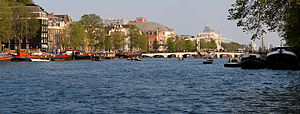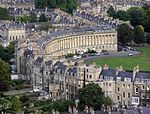Portal:Europe

Europe is a continent that comprises the westernmost part of Eurasia. Europe is bordered by the Arctic Ocean to the north, the Atlantic Ocean to the west, and the Mediterranean Sea to the south. To the east and southeast, Europe is generally considered as separated from Asia by the watershed divides of the Ural and Caucasus Mountains, the Ural River, the Caspian and Black Seas, and the waterways of the Turkish Straits. Yet the non-oceanic borders of Europe—a concept dating back to classical antiquity—are arbitrary. The primarily physiographic term "continent" as applied to Europe also incorporates cultural and political elements whose discontinuities are not always reflected by the continent's current overland boundaries. Europe covers about 10,180,000 square kilometres (3,930,000 sq mi), or 2% of the Earth's surface (6.8% of land area). Politically, Europe is divided into about fifty sovereign states of which the Russian Federation is the largest and most populous, spanning 39% of the continent and comprising 15% of its population. Europe had a total population of about 740 million (about 11% of world population) as of 2012.
The culture of Europe is rooted in the art, architecture, music, literature, and philosophy that originated from the European cultural region. European culture is largely rooted in what is often referred to as its "common cultural heritage". As a continent, the economy of Europe is currently the largest on Earth and it is the richest region as measured by assets under management with over $32.7 trillion compared to North America's $27.1 trillion in 2008. In 2009 Europe remained the wealthiest region. Its $37.1 trillion in assets under management represented one-third of the world's wealth. It was one of several regions where wealth surpassed its precrisis year-end peak. As with other continents, Europe has a large variation of wealth among its countries. The richer states tend to be in the West; some of the Central and Eastern European economies are still emerging from the collapse of the Soviet Union and the breakup of Yugoslavia. Featured panoramaRüdesheim am Rhein is a winemaking town in the Rhine Gorge and thereby part of the UNESCO World Heritage Site. It lies in the Rheingau-Taunus-Kreis district in the Regierungsbezirk of Darmstadt in Hesse, Germany. It is officially known as Rüdesheim am Rhein, which distinguishes it from Rüdesheim an der Nahe. Featured article
The Palace of Queluz is a Portuguese 18th-century palace located at Queluz, a freguesia of the modern-day Sintra Municipality, in the Lisbon District. One of the last great Rococo buildings to be designed in Europe,the palace was conceived as a summer retreat for Dom Pedro of Braganza, later to become husband and then king consort to his own niece, Queen Maria I. It served as a discreet place of incarceration for Queen Maria as her descent into madness continued in the years following Dom Pedro's death in 1786. Following the destruction by fire of the Ajuda Palace in 1794, Queluz Palace became the official residence of the Portuguese prince regent, John VI, and his family and remained so until the Royal Family fled to the Portuguese colony of Brazil in 1807 following the French invasion of Portugal.
Work on the palace began in 1747 under the architect Mateus Vicente de Oliveira. Despite being far smaller, the palace is often referred to as the Portuguese Versailles. From 1826, the palace slowly fell from favour with the Portuguese sovereigns. In 1908, it became the property of the state. Following a serious fire in 1934, which gutted one-third of the interior, the palace was extensively restored, and today is open to the public as a major tourist attraction. One wing of the palace, the Pavilion of Dona Maria, built between 1785 and 1792 by the architect Manuel Caetano de Sousa, is now a guest house allocated to foreign heads of state visiting Portugal. Featured portraitDona Maria I (1734 –1816) was Queen of Portugal, Brazil, and the Algarves. Known as Maria the Pious (in Portugal), or Maria the Mad (in Brazil), she was the first undisputed Queen regnant of Portugal. With Napoleon's European conquests, her court, then under the direction of Prince Dom João, the Prince Regent, moved to Brazil, then a Portuguese colony. Later on, Brazil would be elevated from the rank of a colony to that of a kingdom, with the consequential formation of the United Kingdom of Portugal, Brazil and the Algarves. Featured pictureThe river Amstel, flowing through the centre of Amsterdam. Visible are some of the city's most important landmarks located adjacent to the river in this panorama, such as the Magere Brug (crossing the river), the Koninklijk Theater Carré, Amstel Hotel and Rembrandt Tower. Featured biography
Grand Duchess Olga Nikolaevna of Russia (November 15 [O.S. November 3] 1895 – July 17, 1918) was the eldest daughter of the last Tsar of the Russian Empire, Emperor Nicholas II, and of Empress Alexandra of Russia.
During her lifetime, Olga's future marriage was the subject of great speculation within Russia. Matches were rumored with Grand Duke Dmitri Pavlovich of Russia, Crown Prince Carol of Romania, Edward, Prince of Wales, eldest son of Britain's George V, and with Crown Prince Alexander of Serbia. Olga herself wanted to marry a Russian and remain in her home country. During World War I, Olga nursed wounded soldiers in a military hospital until her own nerves gave out and, thereafter, oversaw administrative duties at the hospital. Olga's murder following the Russian Revolution of 1917 resulted in her canonization as a passion bearer by the Russian Orthodox Church. In later years, when dozens of people made claims to be surviving members of the imperial family, a woman named Marga Boodts claimed to be Grand Duchess Olga, but her claim was not taken seriously. Olga was assassinated along with her family at Yekaterinburg. Her remains were identified through DNA testing and were buried during a funeral ceremony in 1998 at Peter and Paul Cathedral in St. Petersburg along with those of her parents and two of her sisters. Featured location
Bath is a city in the ceremonial county of Somerset, England, known for its Roman-built baths. In 2011, the population was 88,859. Bath is in the valley of the River Avon, 97 miles (156 km) west of London and 11 miles (18 km) south-east of Bristol. The city became a World Heritage Site in 1987.
The city became a spa with the Latin name Aquæ Sulis ("the waters of Sulis") c. AD 60 when the Romans built baths and a temple in the valley of the River Avon, although hot springs were known even before then. Bath Abbey was founded in the 7th century and became a religious centre; the building was rebuilt in the 12th and 16th centuries. In the 17th century, claims were made for the curative properties of water from the springs, and Bath became popular as a spa town in the Georgian era. Georgian architecture, crafted from Bath stone, includes the Royal Crescent, Circus, Pump Room and Assembly Rooms where Beau Nash presided over the city's social life from 1705 until his death in 1761. Many of the streets and squares were laid out by John Wood, the Elder, and in the 18th century the city became fashionable and the population grew. Jane Austen lived in Bath in the early 19th century. Further building was undertaken in the 19th century and following the Bath Blitz in World War II. Associated Wikimedia |






